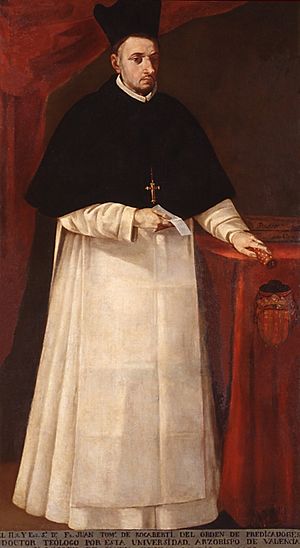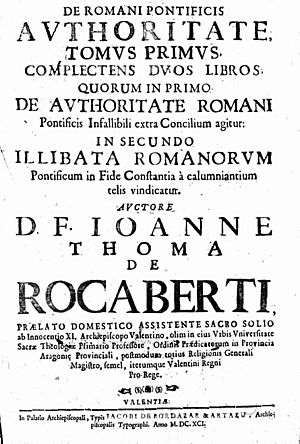Juan Tomás de Rocaberti facts for kids
Quick facts for kids His Grace Joan Tomàs de Rocabertí |
|
|---|---|
| Archbishop of Valencia | |
 |
|
| Church | Roman Catholic |
| Archdiocese | Valencia |
| See | Basilica of the Assumption of Our Lady of Valencia |
| Enthroned | 8 February 1677 |
| Reign ended | 13 June 1699 |
| Predecessor | Luis Alfonso de los Cameros |
| Successor | Antonio Folc de Cardona |
| Personal details | |
| Born | 4 March 1627 Perelada, Catalonia, Spain |
| Died | 13 June 1699 (aged 72) Madrid, Spain |
| Nationality | Spanish |
| Alma mater | University of Girona |
Juan Tomás de Rocabertí (born March 4, 1627 – died June 13, 1699) was an important religious leader from Catalonia, a region in Spain. He was a theologian, which means he studied and wrote about religious ideas and beliefs. He became a very high-ranking official in the Roman Catholic Church.
Contents
A Life of Faith and Leadership
Juan Tomás de Rocabertí was born in 1627 in Perelada, Catalonia, Spain. His family was noble, meaning they had a high social rank. He studied in Girona and, in 1640, he joined the Dominican Order, a group of Catholic priests and brothers.
Becoming a Professor
Rocabertí was very good at studying theology, which is the study of religious faith and practice. Because of his success, he became a professor of theology at the University of Valencia. This was a big achievement for him.
Leading the Dominicans
In 1666, he was chosen to be the leader of the Dominican Order in the region of Aragon. Then, in 1670, he was elected as the General of the entire Dominican Order. This meant he was the worldwide leader of all Dominicans. A famous Dominican theologian, Vincent Contenson, even dedicated his book Theologia mentis et cordis to Rocabertí.
High Positions in Spain
In 1676, Carlos II of Spain, the King of Spain at the time, appointed Rocabertí as the Archbishop of Valencia. An archbishop is a very important bishop who leads a large area of churches. He also became the governor of that province. Later, in 1695, he was made the inquisitor-general of Spain. This was a powerful position in the Church, responsible for upholding religious teachings.
Recognizing Saints
During his time as a leader, Rocabertí helped in the process of making several people saints or blessed. He helped with the canonization of Saint Louis Bertrand and Rose of Lima. Canonization is the official declaration that a deceased person is a saint. He also helped with the beatification of Pius V, which is a step before becoming a saint.
A Simple Life
Even though he held powerful positions, Rocabertí lived a very simple and strict life. A historian named John Langdon-Davies described him as someone who "never wore linen or silk." He only ate vegetables and fish, and his bed was very hard, not soft and comfortable. He died in Madrid in 1699.
His Ideas and Writings
Rocabertí is best known for strongly defending the papacy, which means the office and authority of the Pope. He wrote against groups like the Gallicans (who believed the French king had more power over the Church in France than the Pope) and Protestants (who had separated from the Catholic Church). He was an apologist, someone who defends a particular belief or doctrine.
Important Books
His first major work was De Romani pontificis in temporalibus auctoritate. This book, published in three volumes between 1691 and 1694, discussed the Pope's authority in worldly matters.
His most important work is the Bibliotheca Maxima Pontificia. This huge work, published in 21 volumes, was a collection of important writings that supported the Pope's leadership. He gathered and published many works that dealt with the Pope's special role from a Catholic point of view.
Works
- De Romani pontificis in temporalibus auctoritate, 3 vols., Valentia, 1691–94. (This book explored the Pope's power in non-religious matters.)
- Bibliotheca Maxima Pontificia, 21 vols., Rome, 1697–1700. (This was a large collection of writings supporting the Pope's authority.)
See also
 In Spanish: Juan Tomás de Rocabertí para niños
In Spanish: Juan Tomás de Rocabertí para niños


